The CSS Solved General Science & Ability (GSA) Past Paper 2022 is Solved by Pakistan’s top GSA Coaches, Miss Iqra Ali and Sir Ammar Hashmi. They are the only coaches available in Pakistan who have solved the last 20 years GSA solved papers to help aspirants know how to attempt the paper to score above 80. And they have guided thousands of CSS and PMS aspirants. Both coaches have been known for their teaching methodology and imparting concepts to their students, who scored the highest marks in this subject. At the special request of CSSPrepForum, both coaches have solved the paper.

Question – 02
(A) What do you know about volcanoes? Discuss the causes and effects of a volcanic eruption.
Question Breakdown
In this question, the examiner asked you to throw some light on what is the volcano. So, you need to start explaining the term in your own words rather than copying from any book or source. When done, the next step is to write on what causes volcanic eruption and its impacts, especially on the environment and layers of the atmosphere. Remember, writing too much will never reward you highest marks; what awards you maximum marks is to address what is asked. Lastly, to score maximum marks, you should also draw a diagram of how volcanic eruption occurs. Remember, in the GSA paper, creativity is the key to making yourself stand out from other aspirants.
Answer
What are volcanoes?
Volcanoes are essentially the vents on the earth’s crust through underground molten mineral matter-magma- is erupted due to the density variation within the volcano. When the magma reaches the surface, as lava, it cools and hardens in the form of a dome or crust. Most volcanoes appear along the sides of the tectonic plates- plates that make up the surface of the world.
For Example
✓ The Pacific Ring of Fire includes two-thirds of the world’s volcanoes
✓ Mount Pinatubo, Philippines
✓ Mount Etna, Italy (etc.)
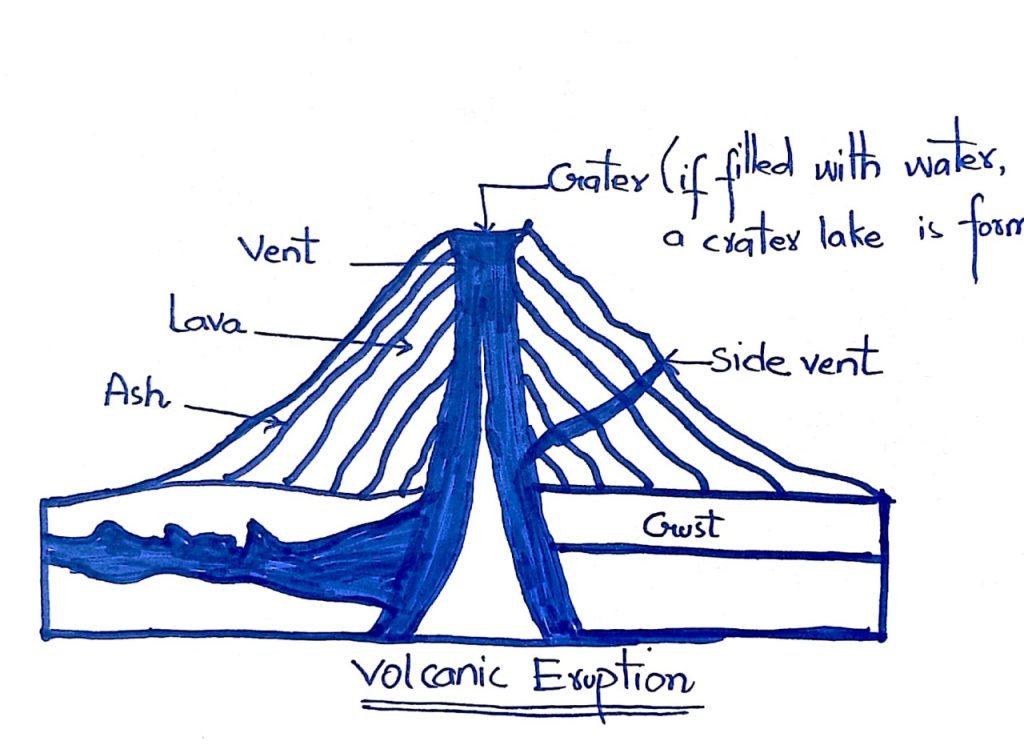
Causes of volcanic eruption
Although there can be multiple causes of Volcanic eruptions, the following are predominant.
1- Movement of tectonic plates
✓ When the tectonic plates move towards each other below magma, sediments and seawater are forced into the chamber, which eventually overflows, and the eruption of the volcano takes place.
✓ When the tectonic plates move away from each other, magma from the bottom is allowed to rise to fill the gap, which causes an eruption.
2- The pressure from the saturated gases in the magma
The magma, in the interior of the earth, is often saturated with gases like carbon dioxide, and hydrogen sulfide. When the gases exert pressure together with water vapours, the highly explosive magma is forced out as lava on the surface of the earth.
Effects of volcanic eruption
• Positive effects
✓ The temperature of the earth is very high near volcanic eruptions. Thus, the sites where magma is very close to the surface can be used to produce geothermal energy to ameliorate the renewable energy utilization
✓ Additionally, ash extruded from the volcano can be used as a fertilizer for soils.
✓ Volcano sites attract many tourists around the world to enjoy astonishing views.
• Negative effects
✓ Volcanoes can reflect sunlight back from the stratosphere, which causes abrupt cooling of the temperature, thus damaging vegetation.
✓ The volcanic gases can cause severe respiratory problems to humans, and pose potential hazards to animals and agriculture.
✓ The accumulation of sulfur dioxide gas and carbon dioxide from the volcanic eruption in the stratosphere can cause acid rain, air pollution, and global warming.
✓ The volcanic eruptions can aggravate earthquakes, tsunamis, and other natural calamities.

(B) Differentiate between renewable and nonrenewable sources of energy. Briefly explain wind energy, solar energy, and biofuels.
Question Breakdown
In the first part of this question, the examiner has asked you to write down all the possible differences between renewable and non-renewable energy resources. Writing examples along with explaining the differences is what will award you maximum marks. Second, explaining wind energy, solar energy, and biofuels along with their pros and cons will make your paper stand out in the competitive exams. Lastly, in this question, you do not need to draw any diagram.
Answer
Renewable versus Non-Renewable Energy Sources
| Renewable Energy Sources | Non-Renewable Energy Sources |
| Renewable energy resources are the energy resources that are naturally replenished on a human timescale. | Non-renewable energy resources are the energy resources that are not replenished naturally on a human timescale. |
| For example Solar radiation Wind energy Hydropower Biomass | For example Nuclear Energy Coal Natural gas Oil |
| These relatively contain low carbon, and thus are environmentally friendly. | These relatively contain high carbon, and thus are hazardous to the environment. |
| Renewable resources are inexhaustible and reusable | Nonrenewable energy resources are exhaustible and cannot be re-used. |
| Although the initial cost of utilization of renewable energy sources is high, the maintenance cost is quite low with high durability. | Both initial and maintenance costs of utilization of non-renewable energy sources are high. |
Wind Energy:
Wind energy is one of the fastest–spreading renewable energy, particularly in areas with strong wind speed. As the name explains, in wind energy projects, the wind is used to harness the power through the kinetic energy created by the air in motion. The power is transformed into electric energy through large-scale wind turbines or wind energy conversion systems.
Pros of wind energy:
✓ Since wind energy is renewable energy, it is an inexhaustible and sustainable source of power generation with negligible effects on the environment.
✓ Wind energy is cost-effective, especially in regions with strong wind speed because, theoretically, when wind speed doubles, wind power potential increases eight times.
Cons of wind energy:
✓ Wind energy units are a threat to wildlife.
✓ Wind Power can be harnessed at certain locations only.
Solar Energy:
As the name indicates, in solar energy, solar radiations are utilized to produce thermal or electrical energy. It is also the cleanest and the most abundant renewable source of energy like wind. When the radiations from the sun collide with the photovoltaic cells of specially designed solar panels, electric power is generated that is used to meet the electricity needs. As the direct energy from the sun can only be utilized during the daytime, the storage batteries are attached to the system to be used at night.
Pros of solar energy:
✓ Like wind energy, solar energy is also pollution-free and reusable and does not require water for cooling.
✓ It does not require huge machinery to function; the smallest functional panels come in sizes that range from 0.6 x 2.55 inches.
Cons of solar energy:
✓ The initial cost of solar energy is relatively high
✓ Solar energy is highly weather dependent.
Biofuels:
Any fuel that is obtained from biomass- plants, algae, animal wastes, etc., comes under the category of biofuels. Since they are directly or indirectly extracted from living organisms, they are also non-renewable energy resources. They can be efficiently used as a cheap and environment-friendly alternative to fossil fuels that are hazardous as well as non-renewable. In biofuel energy production, biomass is combusted at high pressure and temperature to produce steam. The steam then drives the power generators through the rotation of the turbines. Particularly, liquid biofuels, like ethanol, are preferred as they are easier to use and transport.
Pros of biofuels
✓ Biofuels, like all, other renewable energy sources are sustainable and cheap.
✓ Biofuels reduce the reliance on expensive, depleting, and environment hazardous fossil fuels.
Cons of biofuels
✓ They have serious environmental drawbacks, for the major electricity from biofuels is produced by direct combustion.
✓ A large amount of raw material has to be used to harness a small amount of energy.
(C) What is a Tornado? How is it formed and what are the effects of tornadoes? Explain briefly
Question Breakdown:
In this question, the examiner has asked you to define a tornado. So, first of all, give a brief explanation about the term in 4 to 5 lines in your own words. When done, move towards the next thing being asked in the question which is the formation of tornadoes. Explain the formation in bullets with a very brief explanation and also draw the diagram to bring creativity. Lastly, explain the effects of tornadoes in chronological order i.e., damage intensity and the damages.
Answer
Define Tornado:
A tornado is a small but intense vortex of rising air associated with the strong updraft of an intense thunderstorm. It generally occurs in mid-latitude. The airspeed of tornadoes ranges from 40-300+ mph and width varies from a few yards to more than a mile. Apparently, it is a dark funnel cloud hanging from the base of a dense cumulonimbus cloud. While moving around the countryside, it writhes and twists, and where it touches the ground, it can destroy almost everything.
Formation of the tornado:
Although the appearance of tornadoes varies widely, the following are the steps through which tornadoes form.
1- Storm Development Stage:
When sun radiations reach the earth’s surface, they warm up the air near ground level. As a result, localized warm air pockets are formed, resulting in an unstable atmosphere. The air pockets then rise and form shallow cumulus clouds. The cumulus cloud then rises while the surrounding temperature starts decreasing with height. The clouds are then transformed into cumulonimbus clouds with the help of the current of ascending air- updrafts.
2- Storm organization Stage:
In regions with significant wind shear- change in wind speed and direction with height, the updrafts start rotating, and a horizontal spin is created in the atmosphere. Gradually, as the strength of updrafts increases, the rolling motion is tilted vertically so that the spin occurs about a vertical axis.
3- Tornado maturation Stage:
Ultimately, the rotation becomes so concentrated that a narrow column of violently rotating air. If the fierce column of air reaches the ground, a tornado is created officially. A tornado is typically a funnel-shaped cloud that forms due to the relatively low pressure within the tornado outside. Additionally, the black colour of the funnel is due to the collected dust and debris.
4- Tornado dissipation Stage:
In the dissipation stage, downdrafts or air eventually surrounds the tornado, cutting off the supply of warm air. Now, the tornado narrows, and the funnel dissipates.
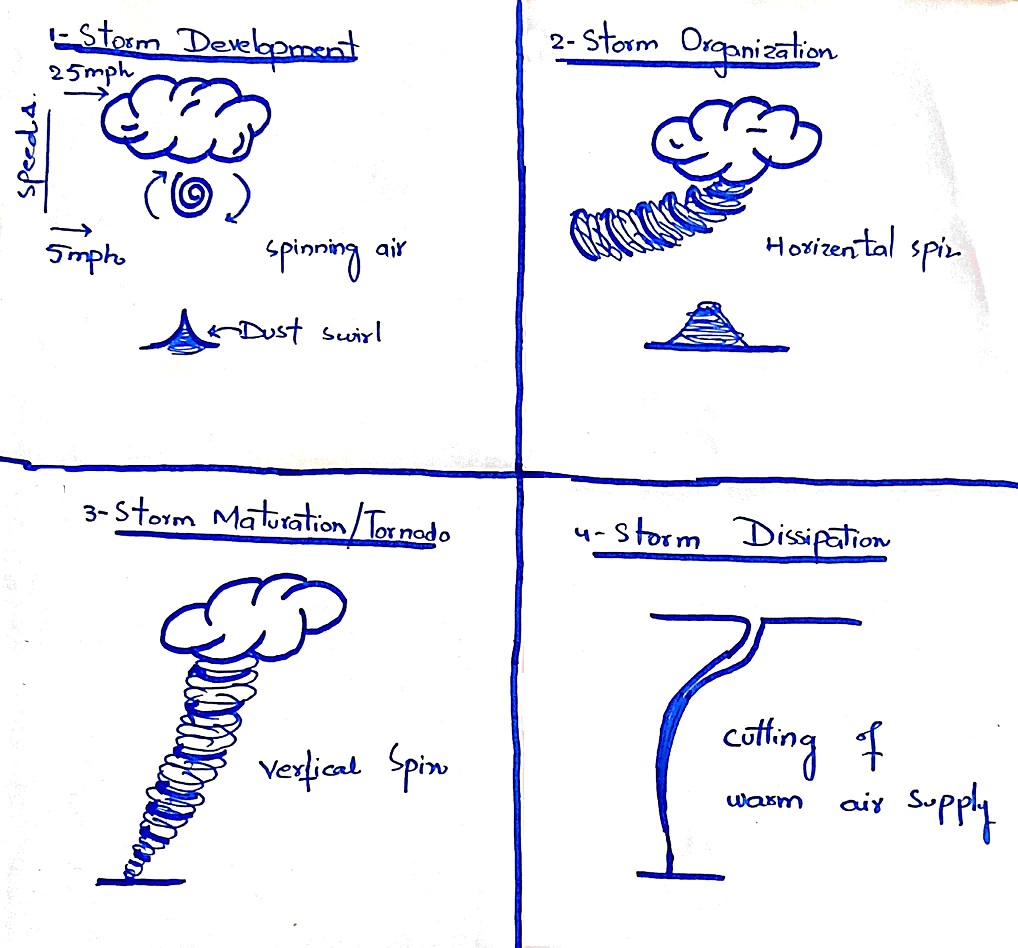
Effects of tornado:
Devastation from these tornadoes is often complete within the narrow limits of their paths. The Enhanced Fujita intensity scale is a scale generally used to measure the intensity of tornadoes’ destruction based on their speed. It can be classified as:
| Damage Intensity | Speed of tornado | Damages |
| Light Damage | (65–85 mi/hr) | Chimneys are damaged, tree branches are broken, shallow-rooted trees are toppled. |
| Moderate damage | (86–110 mi/hr) | Roof surfaces are peeled off, some tree trunks are broken, garages and trailer homes are destroyed. |
| Considerable damage | (111–135 mi/hr) | Roofs are damaged, trailer homes and outbuildings are destroyed, large trees are uprooted or snapped |
| Severe damage | (136–165 mi/hr) | Roofs and walls are torn from structures, small buildings are destroyed, non-reinforced masonry buildings are destroyed, forest are uprooted |
| Devastating damage | (166–200 mi/hr) | Homes are destroyed, cars are blown some distance, and debris includes large objects. |
| Incredible damage | (>200 mi/hr) | Strong homes are lifted from foundations, concrete structures are damaged, damage from debris the size of automobiles, and trees are debarked |
(D) Discuss various factors which affect the variation in the climate of a place?
Question Breakdown:
In this question, the examiner has asked you to describe different factors affecting the variations in the climate of a place. First of all, you will explain what is meant by the term climate. When done, write down the natural factors affecting its variations in bullets with an examination of each factor in 2-3 lines. After writing the natural factors, explain all the possible anthropogenic factors affecting climate. Moreover, try to add international reports about anthropogenic changes in climate. Lastly, making a diagram separately for each natural factor is what will reward you with maximum marks.
Answer:
Climate and factors affecting climate:
Climate is the average weather condition of a region over a long period of time. Although international conventions now designate 30 years as the minimum period for defining a climate, the following factors contribute to its variation which in one way or another affects temperature and perception.
(A) Natural Factors
1- Altitude/ Elevation
The height measured from sea level is called altitude. At low altitudes, the density of air is high, so the temperature is higher than at high altitudes. However, as the altitude increases, the temperature of the air gradually decreases. With every increase of 160-165m of latitude, the temperature decreases by 1 degree.
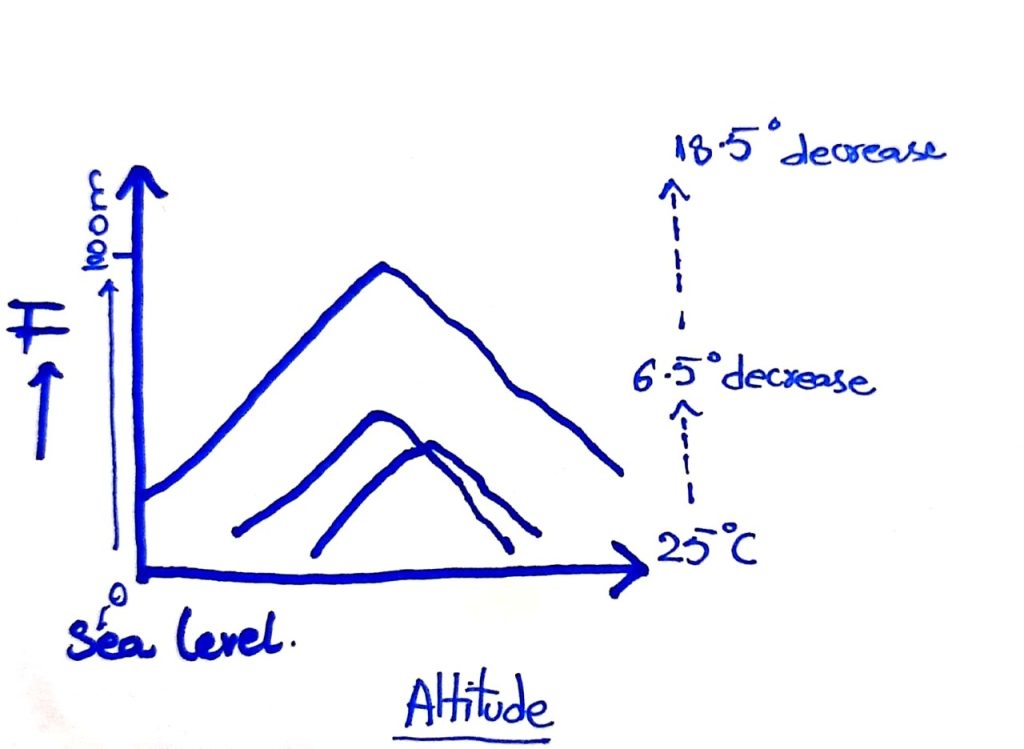
2- Latitude
Latitude is another important factor that influences the climate of a place. When latitude- the distance from the equator- increases, the distance from the sun increases, which causes a decrease in temperature. Thus, at the equator-which lies very near to the sun- temperature throughout the year is high. On the other hand, at the poles, the temperature is relatively low because it lies far away from the sun. Thus, the temperature at both the north and south poles is so cold that no plant or animal can survive there.
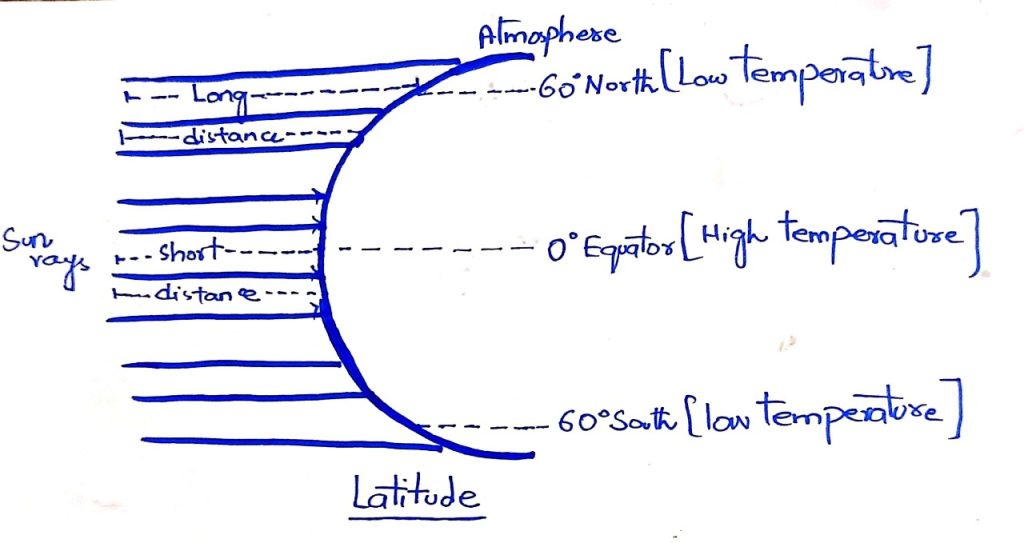
3- Distance from the sea
Distance from oceans and other water bodies also influences temperature. As the distance from the water bodies increases the temperature increases because the water bodies got heated and cool down more slowly than land. Moreover, during summer, in the regions near oceans, there is relatively more rainfall due to more evaporation than in the regions away from oceans.
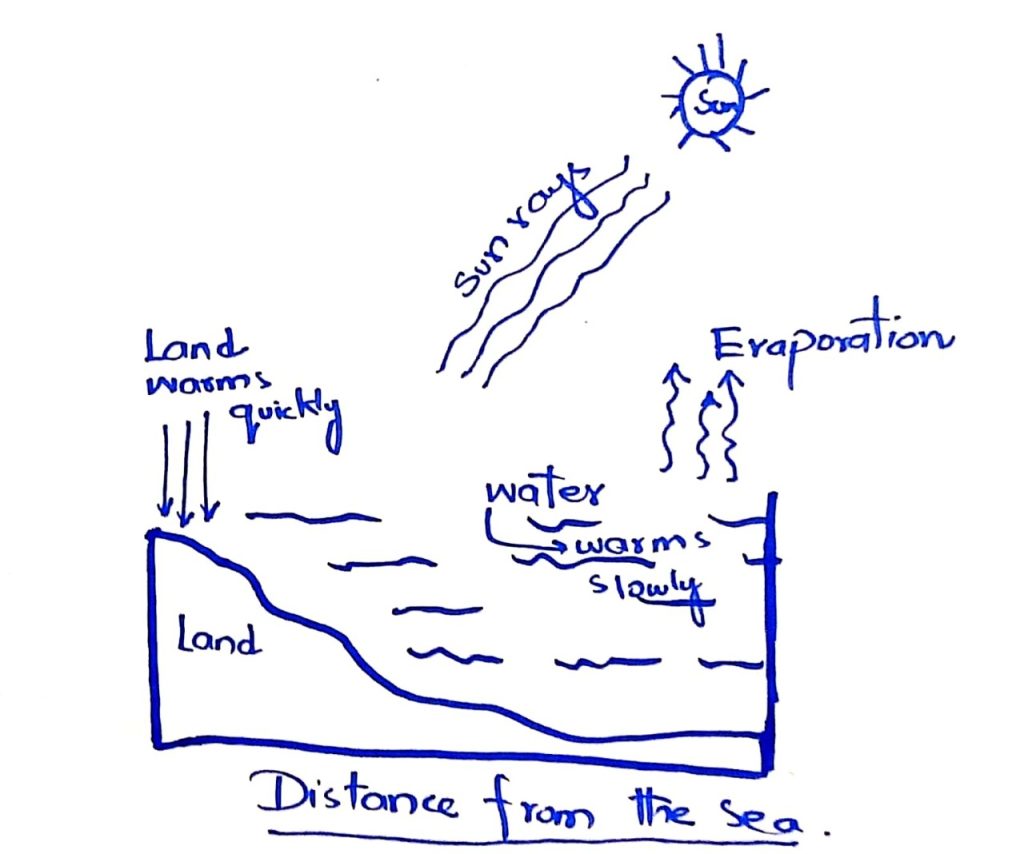
4- Ocean currents
The movement of ocean water depends on the sea breeze and temperature. Since the equatorial region is very hot, so the air coming from the equator to the pole is warm. Contrarily, the air coming from the poles is cold. So, in the area where there is a warm ocean current, the climate is warmer. Likewise, the climate is colder where there is a cold current.
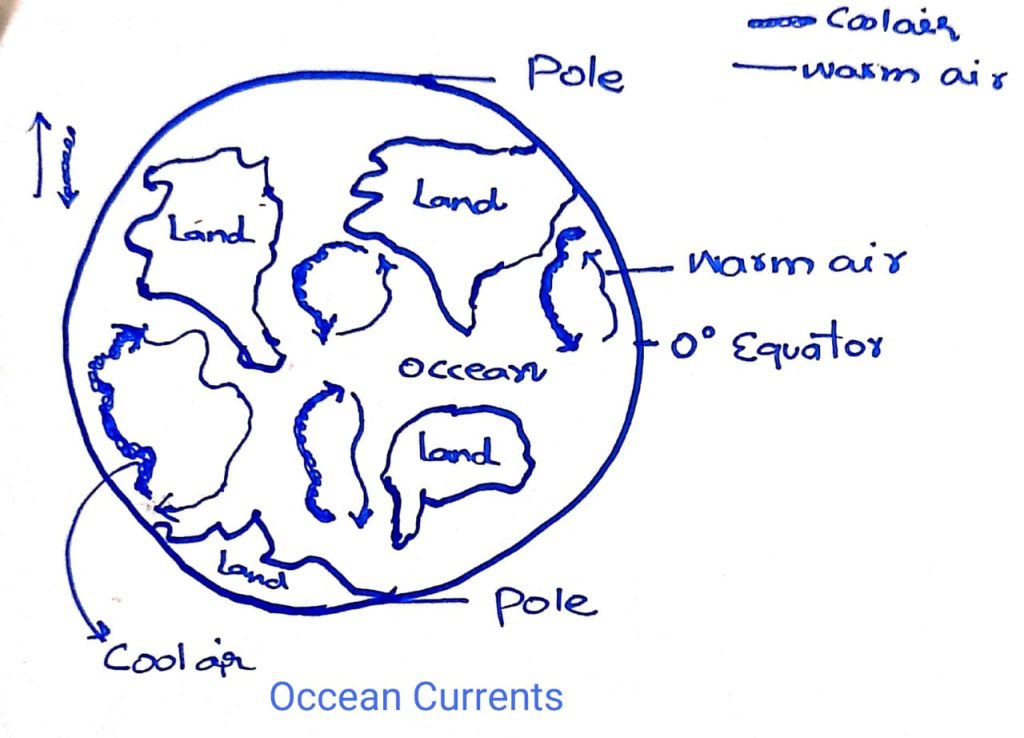
(B) Anthropogenic Factors
(1) Excessive use of fossil fuels
According to “The Economist”, almost 80% of the world’s energy is comprised of fossil fuels. Consequently, considerable emission of carbon and toxic gases trap the sun’s rays to bounce back which in turn becomes the primary cause of variation in the climate.
(2) Deforestation:
Being the second biggest cause of climate change, deforestation is another major factor which plays an important role in the variations in the climate of a place.
(3) Growing Industries and Rapid Urbanization
The capitalist world has adhered to the policy of speedy industrialization. Consequently, enormous greenhouse gases (GHGs) are being produced resulting in variation in the climate. Moreover, rapid urbanization is also a major factor causing climate change. Intergovernmental Panel on Climate Change (IPCC) estimates show that around 21% of GHGs are the result of burgeoning industrialization.

Question-03
(a) Discuss vaccination, types of vaccines, their side effects and effectiveness.
Question Breakdown:
In this question, the examiner has asked you to describe and discuss vaccination in your own words briefly. When done, define vaccines first and then describe the 4-5 main types of vaccines. After explaining the types, write down the side effects of vaccines with a division of these side effects i.e., mild, moderate, and severe. When done, explain the effectiveness of all the above-mentioned types of vaccines in your own words in 8-10 sentences. Lastly, you do not need to draw any diagram for this question.
Answer:
Vaccination:
Vaccination is a process that is carried out to make people immune from viral or bacterial diseases or epidemics, such as polio, measles, pneumonia, etc. they are vaccinated in their early life.
Vaccine:
Vaccines are inactivated or dead microorganisms or toxins that are used to provide immunity against a disease or may prevent infection. They prevent us from both bacterial and viral diseases.
For example, MMR (measles, mumps, rubella), HPV (Human papillomavirus vaccines), and polio vaccine
Types of vaccines:
Vaccines are of different types-live and attenuated (vaccines against chickenpox), inactivated (BCG vaccine), subunit (Hepatitis C), toxoid, conjugate, DNA, recombinant vector vaccines, and other experimental vaccines.
- Inactivated vaccines:
These are the vaccines that usually do not provide immunity strongly as live vaccines, but their booster shots over time may need to get ongoing immunity against a disease. For example, Flu, Polio, Hepatitis A, and Rabies vaccines are inactivated vaccines.
- Live-attenuated vaccines:
Live vaccines are the vaccines in which a weakened form of the disease-causing germ is used to prevent a natural infection, and they create a long-lasting response. Moreover, these vaccines are strong enough that 1 or 2 doses give lifetime protection to an individual against a disease-causing germ. Live vaccines give protection against some famous diseases, like smallpox, measles, yellow fever, rotavirus, mumps, and rubella.
- Messenger RNA (mRNA) vaccines:
Messenger RNA or mRNA vaccines are the vaccines, which form protein in the body that is used to trigger an immune response. The immune response triggered by the protein formed by the vaccine in the body is helped an individual to fight against infection. Moreover, mRNA vaccines have many benefits, including easy handling, manufacturing, and no risk of causing disease in the vaccinated person. COVID-19 vaccination is the best example of an mRNA vaccine.
- Subunit, recombinant, polysaccharide, and conjugate vaccines:
Specific pieces of germs body, such as capsid, protein content, and sugars are used in the formation of subunits, polysaccharides, recombinant, and conjugate vaccines. These vaccines are used to protect against some common diseases, such as Hepatitis B, Pneumococcal disease, Meningococcal disease, etc. Lastly, these vaccines need booster shots in case to get ongoing protection against diseases.
- Toxoid vaccines:
Toxoid vaccines are having targeted immune responses and create immunity or resistance against the disease-causing part of a germ instead of its whole body. In toxoid vaccines, an individual may need booster shots to overcome ongoing disease. Tetanus and diphtheria vaccines are toxoid vaccines.
Side effects
Side effects of vaccines are not severe, so mild soreness, redness, and swellings are observed at the injection site. Moreover, some vaccines are correlated with pyrexia, rash, and mild pain, but severe side effects, such as allergic reactions or life-threatening seizures are rare. To see the possible side effects, the smallpox vaccine is a best-known or familiar example in this regard
Normal or mild side effects:
✓ Fever (100-1020 F) and rash(mild) that lasting usually 3-4 days
✓ Soreness or swelling of lymph nodes that lasting usually 3-4 weeks
Temperate to severe side effects:
✓ Loss of vision or acute eye infection (if vaccine virus spread to the eyes)
✓ Full body rash, Eczema, and severe infection at the vaccination sites
✓ Brain infection (encephalitis) or death (in rare cases)
Effectiveness of vaccines:
Vaccines have significantly contributed to improving health and also to increase the longevity of human beings. Moreover, Vaccines strengthen our immune system so infections can’t get started, and act against both bacteria and viruses. Vaccines enhance natural immunity. Furthermore, by vaccination, polio cases declined by ninety-nine per cent and smallpox was eradicated worldwide. Therefore, by seeing the effectiveness of vaccines, a large number of vaccines are produced, such as mumps, measles, typhoid, cholera, yellow fever, hepatitis A, B, and fever, etc. Lastly, some vaccines are not 100% effective, but these vaccines are used for that population that is at higher disease risk. For example, COVID-19 vaccination effectiveness can be seen easily in the picture below.
(B) What is polio? Discuss its symptoms, causes of spreading, prevention and vaccine.
Question Breakdown:
In this question, first of all, define polio in your own words. When done, write down all the possible symptoms related to this particular disease. Second, write down the causes of its spreading in bullet form. Remember, writing too much will never award you good marks; therefore, try to stay relevant while attempting a GSA paper. Third, describe prevention methods and vaccines available for this purpose. Lastly, you do not need to draw any diagram for this question.
Answer:
Polio:
Poliomyelitis or poliovirus mostly occurred in childhood, and it is found all over the world. This is the smaller known virus that contains RNA in a spherical capsid and mostly occurred in children younger than five years.
Symptoms:
✓ Muscles pain and stiffness (especially back, neck, arms, and legs)
✓ Headache and sore throat
✓ Fever, fatigue, and nausea or vomiting
Causes of spreading:
It may spread through
✓ Stool
✓ Contaminated water and food
✓ Saliva
Prevention and Vaccine
Currently, to prevent children from polio, two types of vaccines are available. Four shots of vaccines at specific intervals (at the age of 2, 4, 6, and 18 months; booster shot at the age of 4-6 years) may prevent a child from polio. Types of vaccines:
✓ Inactivated poliovirus vaccine (IPV)
✓ Live attenuated oral polio vaccine (OPV)
(C) What do you understand by the DNA and RNA?
Question Breakdown:
In this question, start your answer with an explanation about nucleic acids before describing their types i.e., DNA and RNA. Second, explaining the occurrence, composition, units, type of material, synthesis process, and types of DNA and RNA by making a comparison table, is what will make your paper stand out from other aspirants. Lastly, drawing diagrams of both RNA and DNA along with the diagrams of their bases will make you score maximum marks.
Answer:
Nucleic acids:
Nucleic acids are polymers of nucleotides. They were first isolated from nuclei of “pus” cells in 1869 by a German chemist, Friedrich Miescher. Nucleic acids were named due to their isolation from nuclei and their acidic nature.
Nucleic acids are complex substances and these are the polymers of nucleotides units. There are three units in each nucleotide.
- A pentose sugar (5-carbon monosaccharide)
- A nitrogen-containing base
- A phosphoric acid
There are two types of nucleic acids.
- Deoxyribonucleic acid (DNA)
- Ribonucleic acids (RNA)
| Deoxyribonucleic acid (DNA) | Ribonucleic acids (RNA) | |
| Occurrence | ChromosomeNuclei of cellsMitochondria and chloroplast (lesser amount) | Nucleolus RibosomesCytosol Smaller amount in other cells |
| Composition | Double stranded | Single stranded |
| Units | 5 carbons sugar is deoxyribose. | 5 carbons sugar is ribose. |
| Nitrogenous bases | Thymine Adenine Guanine Cytosine | Uracil Adenine Guanine cytosine |
| Type of material | Hereditary material | No hereditary material but used in protein synthesis |
| Synthesis process | Synthesis of DNA is called replication. | Synthesis of RNA is called transcription. |
| Types | A-DNA (right handed, double helix and similar to B-DNA)B-DNA (most common and right handed also)Z-DNA (left handed, double helix and wound in zig-zag pattern) | Messenger RNA (mRNA) (bring genetic message from nucleus to ribosome)Transfer RNA (tRNA) (read the code on mRNA and transfer amino acids to the ribosome)Ribosomal RNA (rRNA) (combine with ribosomal proteins and form ribosomes) |
Diagrammatic representation of DNA and RNA
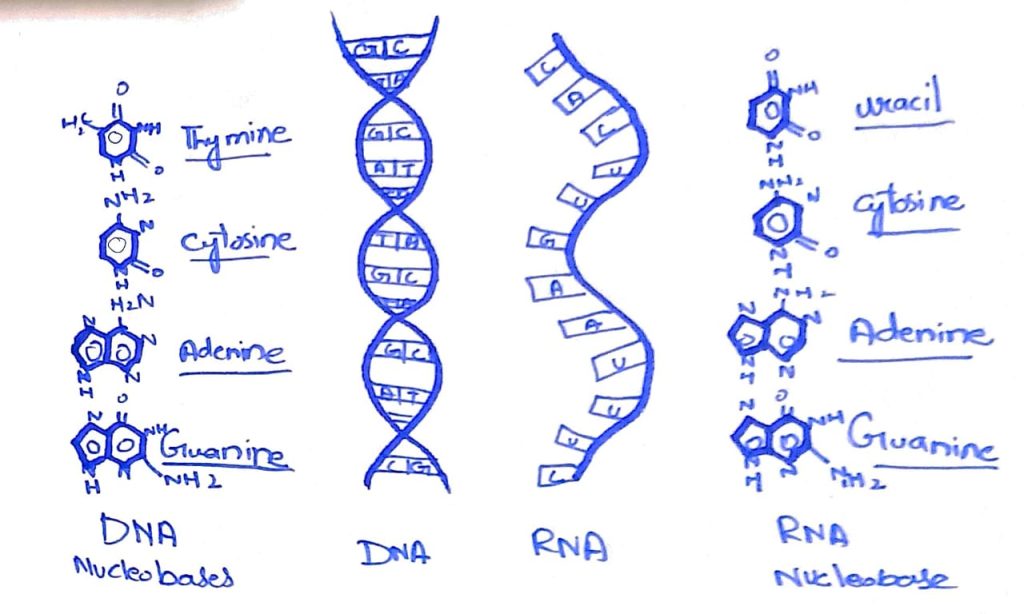
(d) What is solid waste? Discuss the main issues of solid waste management in our country.
Question Breakdown:
In this question, the examiner has asked you to describe solid waste in your own words. Therefore, start your answer with an explanation of solid waste in 7-8 sentences along with examples. When done, write down main issues of its management in Pakistan. For this part, try to explain it in points and bullets to make your paper standout from other aspirants. Lastly, you do not need to draw any diagram or write any solutions. Remember, staying relevant is the key in GSA paper.
Answer:
What is solid waste?
The disposal of domestic refuse, commercial, and industrial solid wastes or semi-solid material is studied under the title solid waste management. The domestic municipal solid waste mostly consists of garbage, waste treatment plants, commercial refuse, air pollution control facilities, construction debris, sludge from the water supply, and other discarded materials.
Issues of solid waste management in our country:
Following are the issues of solid waste management in Pakistan:
- There is no proper waste collection system
- Waste is dumped on the streets
- Different types of waste are not collected separately
- There are no controlled sanitary landfill sites. Opening burning is common.
- Citizens are not aware of the relationship between reckless waste disposal and resulting environmental and public health problems.
Question-04
(a) Define the term Water Pollution. What Indicators are used to measure the quality of water? Write down the drinking water quality standards.
Question Breakdown:
In this question, the examiner has asked you to describe water pollution breifly in your own words. When done, write down all the possible indicators which are used to measure the quality of water. For this part, try to use headings and bullets to explain indicators. Finally, write down the quality standards which are given by a renowned health organisation. Remember, both the indicators and quality standards should be given equal weightage to score maximum marks. However, there is no need of any diagrammatic representation for this question.
Answer:
Water Pollution
Also known as aquatic pollution, water pollution is the contamination of water bodies with harmful substances due to human activities. Such substances include microorganisms and various chemicals which degrade the water quality and render the water toxic to the health of living beings.
Indicators of Water Quality
Following are some indicators that are used to measure the water quality
- Dissolved Oxygen (DO)
Oxygen is an essential component for living beings, microbes, plants, humans, and animals; thus, an increased DO content in water causes exponential growth of bacteria, affecting the water quality. On the other hand, a decreased DO level might cause the death of aquatic life; for instance, below 4.0 mg/L of DO, no species of fish can survive.
- Turbidity and Total Suspended Solids (TSS)
It is the measure of water clarity and cleanliness. Turbidity depends upon the amount of TSS in water; whereas, TSS is formed as a result of organic matter decay and the presence of pollutants and includes clay, silt, sand, gravel, etc.
- Water Temperature
An optimum water temperature supports the life and optimum health of aquatic living things. Thus, fluctuation in water temperature renders aquatic life vulnerable to parasites, diseases, and – even – death.
- Bio-Indicators
As the name implies, bioindicators are biological factors that provide information about water quality. They include planktons, fish, plants, animals, and microorganisms and are determined by the amount of light, temperature, TSS, etc.
- Nitrates
Just like oxygen, nitrogen is also a crucial nutrient for living beings. However, a large number of nitrates (compounds of nitrogen) in water point toward the presence of chemical pollutants, primarily fertilizers. The maximum level of nitrates at which freshwater species are protected is 2 mg NO3-N/l, and that for other animals is 20 mg NO3-N/l.
- pH Scale
The pH scale determines the acidity or basicity of water, which fluctuates owing to the presence of pollutants; automobile and industrial waste, agricultural runoffs, domestic waste, etc. even a subtle fluctuation in the pH of water can have devastating impacts on the aquatic life, as well as the health of consumers.
Drinking-Water Quality Standards
According to World Health Organization, water is considered to be safe to drink if
- It has dissolved oxygen concentrations above 6.5-8 mg/L
- It has turbidity of less than 5 NTU
- It has nitrates less than 10mg/L
- It has a pH of 6.5-8.5.
(b) What do you understand by the term Population Planning? Point out the different benefits of Population Planning.
Question Breakdown:
This question has basically two parts. In the first part, the examiner has asked you to explain population planning in your own words. So, first of all, write down a paragraph of 9-10 lines about population planning. When done, describe all the possible benefits of population planning with headings and bullets. Lastly, there’s no need to draw any diagram in this question.
Answer:
Population Planning:
Population planning is the controlling of unbridled population growth that has painful impacts on the socio-economic fabric of a country. It is the application of such techniques, like reducing fertility by using contraception or sterilization, family planning, improving economic conditions, etc., that would help limit the growth of population. Usually, population planning policies are adopted in densely populated areas or in developing and under developed countries to support the socio-economic conditions.
Benefits of Population Planning
Following are some of the benefits that population planning policies possess
- Improvement of child and maternal health
Too early, late, or often pregnancy can have lethal impacts on women’s health, along with that of their children. Hence, promoting the use of contraceptives can reduce maternal mortality rates by 35%, and a 3-year interval between births can reduce infant mortality rates by 24%.
- Socio-economic empowerment
Empowered women can better take a stand for themselves in family planning and thus improve their and their families’ future. This is possible because the more controlled the population growth, the better the chances for everyone to enjoy quality education and resources, like food, security, housing, and jobs.
- Environmental Protection
A smaller and controlled population can help protect the environment by reducing the strain on resources and, thus, controlling environmental degradation.
(C) Discuss the possible negative effects that Pakistan may face due to Global Warming and Climate Change. What steps may be helpful to control the climate change?
Question Breakdown:
In this question, before discussing the possible negative impacts of global warming, describe both global warming and climate change in your own words briefly in order to build a context for your answer. When done, write down all the possible negative impacts of global warming that Pakistan may face in bullets and points. Finally, describe all the possible suggestions and steps that Pakistan can take to help control these negative impacts. In this question, you do not need to draw any diagram.
Answer:
What is Global Warming?
Simply, global warming is the rise in the average temperature of the earth wreaking havoc on the environment by bringing severe and sudden climate change all around the globe. It is caused by the over usage of fossil fuels and other forms of non-renewable energy resources, along with an inefficient and wasteful usage of renewable energy resources.
What is Climate Change?
Climate change is the set of changes occurring in the earth’s climate on a global or regional scale. This term is usually used to define human-induced changes, also known as anthropogenic changes. Climate change has been brought about by global warming and has, especially, become the center of attention for all after the industrial growth around the world.
Possible Negative Impacts on Pakistan
- Low-lying and coastal areas of Pakistan could be flooded.
- Glaciers would melt bringing about flash floods and causing destruction.
- Biodiversity would be disturbed when food chains start getting disrupted due to the lack of optimum living conditions for animals.
- Agriculture could be disturbed, wreaking havoc on Pakistan’s economy. Moreover, food production could be disturbed by extreme climate changes.
- Famines might become common if there is a lack of rain.
Steps to control climate change:
- Prefer Public transport over private transport.
- Plant more trees
- Invest in clean energy
- Create green jobs
- Become carbon neutral
- Become more energy efficient
- Tax global warming pollution
- Cap CO2 emissions
- Make low polluting biofuels more available
(d) What is Radioactivity? Differentiate between natural and artificial radioactivity.
Question Breakdown:
In this question, the examiner has asked you to describe radioactivity briefly in your own words. When done, draw a comparison table and discuss all the possible differences between natural and artificial radioactivity. Giving examples for both types of radioactivity is what will make your paper standout from other aspirants. However, avoid writing too much and always try to stay relevant to the question. Lastly, no diagrammatic representation is needed for this question.
Answer:
Radioactivity
It is a phenomenon in which radiation is emitted by the disintegration of atomic nuclei of radioactive elements. This process of radioactive decay is spontaneous and occurs because the atomic nucleus wants to attain a stable configuration. For example: A number of radioactive elements are found in nature, the most famous of which are Uranium (U), Radium (Ra), Polonium (Po), etc.
Different types of radioactive decay processes occur in nature; alpha decay, beta decay, and gamma decay, in which a helium ion, an electron, and a photon are released respectively.
| Factors | Natural Radioactivity | Artificial Radioactivity |
| Definition | The process occurs naturally, without any human intervention | The process is induced by human beings |
| Nature of the Process | It is spontaneous | It is not spontaneous and has to be induced and initiated |
| Nature of the Starting Substance | The starting substance or material is unstable | The starting substance or material is stable |
| Is the Process Controllable? | The process is, usually, not controllable | As the process is man-made, it is controllable |
| Where Does It Take Place? | It occurs in nature, anywhere a radioactive substance is present | It is carried out in a lab |
| Example | Natural radioactive decay of Uranium | Artificial Uranium disintegration in nuclear fission reactors to produce energy |

Question-05
(a) What do you understand by the term Remote Sensing? Write its basic principle. Give its important applications.
Question Breakdown:
In this question, the examiner has asked you to describe remote sensing in your own words. When done, explain its basic principle i.e., how it works. While explaining about how it works, diagrammatic representation is what will award you maximum marks. After explaining its basic principle, write down all the possible applications of remote sensing in bullets or points.
Answer:
Remote sensing:
Remote sensing is the most common way of identifying and monitoring the physical characteristics of an area by estimating its reflected and discharged radiation at a distance.
Basic Principle of Remote Sensing:
Remote sensing work in two ways:
- Active Remote Sensing
- Passive Remote Sensing
In active remote sensing, radar waves from a satellite are sent to earth. These waves are recorded on earth on an instrument known as a Remote Sensor.
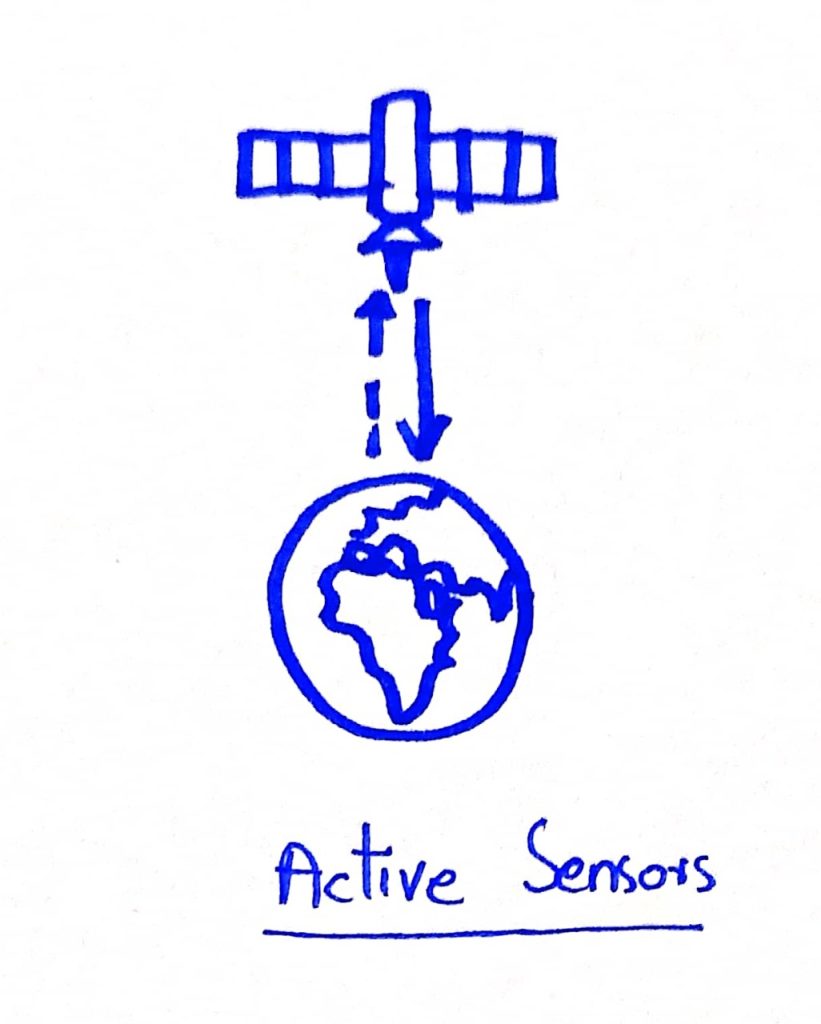
Passive remote sensing depends upon the electromagnetic radiation of the sun. The electromagnetic waves often reflect from the world’s surface or move to the environment as intensity waves from the earth. These waves are recorded on a distant sensor fixed on the satellite. The information achieved from these waves is transformed into Digital Satellite Images. The satellite or airplane on which the remote sensor is set is called the platform
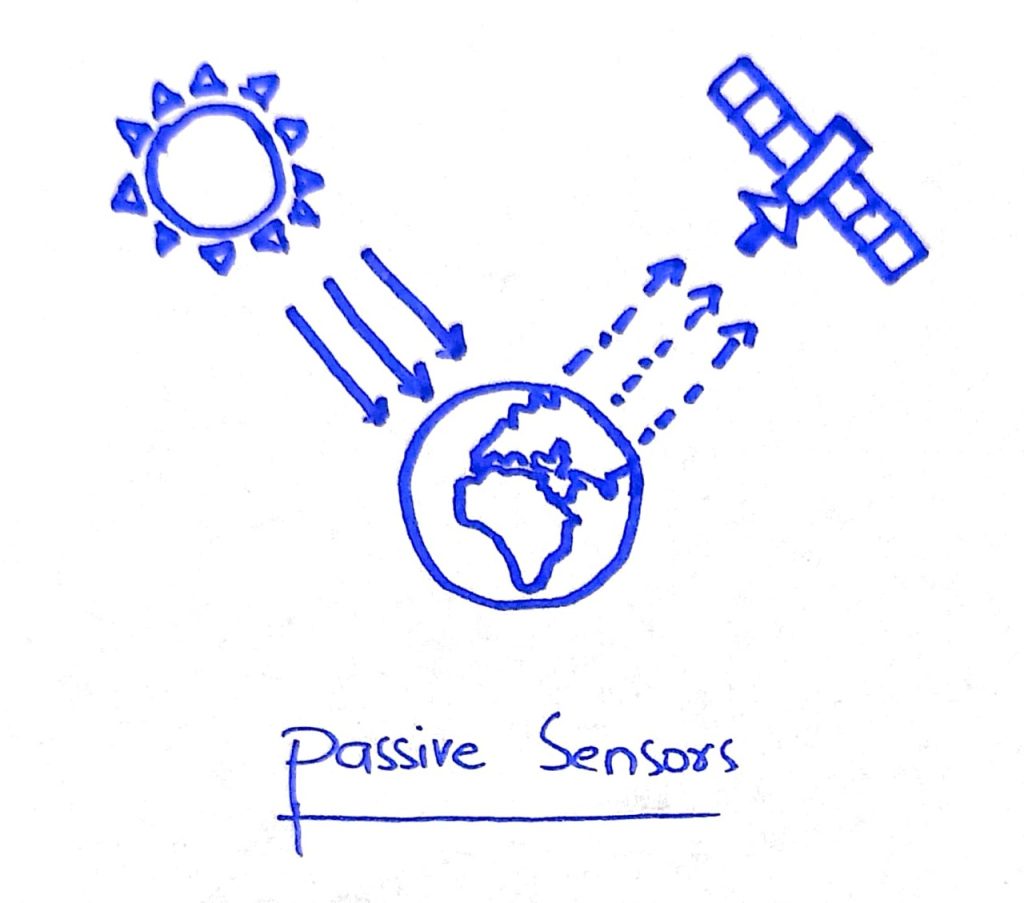
Important Applications:
Important application of remote sensing includes:
- Weather Forecasting
- Forestry
- Agriculture
- Surface changes
- Biodiversity
(b) Explain the optical fiber. Explain how Fiber optic communication works?
Question Breakdown:
In this question, the examiner has asked you to explain optical fibre in your own words. The diagrammatic representation of the components of optical fibre is what will award you maximum marks in this question. When done, write down all its components while explaining the term. When done, describe its operating system i.e., how optic communication works. Remember, staying relevant to the question is the key to crack GSA paper. Therefore, avoid writing too much.
Answer:
Optical Fiber:
Optical fiber is a thin flexible fiber with a glass core through which light signals can be sent with very little loss of strength and transmit more data over longer distances faster than other mediums. Structure wise optical fiber consists on
- Core: thin glass center of fiber where light travels. The Core has a diameter of 10 µm– 200 µm
- Cladding: plastic outer optical material surrounded by Core. The refractive index of the cladding is a less than that of the core which is a must conditions for the working of the Optical Fiber.
- Buffer: A polymer layer surrounded by Cladding.
- Jacket: It coats the whole Optic Fiber.
Working of Fiber Optic communication:
The fiber Optic works on the principle of total internal reflection. When a ray of light is incident on the core of the optical fiber at a small angle, it suffers refraction and strikes the core cladding interface. As the diameter of the fiber is very small hence the angle of incidence is greater than the critical angle. Therefore, the ray suffers total internal reflection at the core cladding interface and strikes the opposite interface. At this interface also the angle of incidence is greater than the critical angle, so it again suffers total internal reflection. Thus, the ray of light reaches the other end of the fiber after suffering repeated total internal reflection along the length of the fiber. At the other end, the ray suffers refraction and emerges out the optical fiber without losing energy.
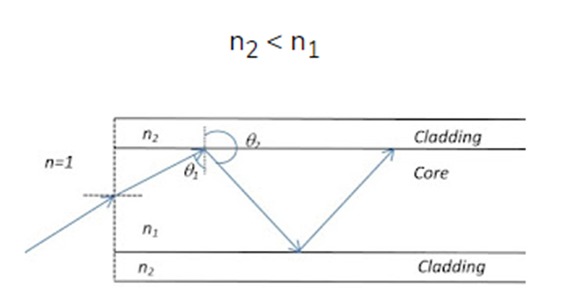
(C) Briefly explain the working and structure of Cellphone?
Question Breakdown:
In this question, the examiner has asked you to write down the structure of Cellphone and how does it work. First of all, describe cellphone briefly in your own words. When done, write down all the steps of its working methodology. In the second part of the question, describe the basic structure of Cellphone in the form of headings with a brief explanation of every part in 4-5 sentences. Lastly, you do not need to draw any diagram in this question.
Answer:
Cellphone:
A cellphone is any portable telephone that uses cellular network technology to make and receive calls.
Working of a Cell phone:
Working of a cell phone consist on three steps
- Radio waves
- Antenna
- Connectivity
Radio waves are used to communicate on cell phones. The electromagnetic field, which is made up of oscillating electric and magnetic fields, transports digitized audio or data via radio waves (EMF). The frequency of oscillation is measured. Radio waves convey data and travel at the speed of light across the air. Moreover, to broadcast or receive radio signals, cell phones include at least one radio antenna. An antenna converts an electric signal into a radio wave (transmitter) and the other way around (receiver). Some cell phones only have one transmitter and receiver antenna, whilst others, like the iPhone 5, have several transmitting and receiving antennas. Furthermore, a cell phone is a two-way wireless communication device that requires both inbound (reception) and outbound (transmission) signals to function. The magnitude of the received signal from the cell tower is called the “signal strength”, which is commonly indicated by the “bars” on your phone. The connectivity between a cell phone and the nearest cell tower depends on both signals and is affected by many factors, such as the number of obstructions between them and the distance between the phone and the nearest cell tower.
Structure of a Cell Phone:
Typically, Cell phone have display (LCD, touch screen), keypad, microphone, speaker, SIM card, battery, memory unit, camera, RF part, DAC/ADC, baseband part, On/Off switch and Bluetooth/GPS features. All these features are based on specific standard specifications designed.
- Baseband Part:
The baseband part in mobile is comprised of a digital signal processor (DSP) to process forward voice/data signals for transmission and to process reverse voice/data signals received.
- ADC and DAC:
ADC (Analog to Digital Converter) and DAC (Digital to Analog Converter) is used to convert analog speech signal to digital signal in the mobile handset.
- Speaker
It turns electrical signals into auditory (pressure vibrations) signals that humans can hear. This is frequently used in conjunction with an audio amplifier to achieve the desired audio signal amplification. It was also linked to a volume control circuit to modify the amplitude of the audio signal.
- Connections (WiFi, Bluetooth, USB, GPS)
WiFi, Bluetooth, and USB have all been developed to make data transfer between mobile phones and other computer devices (laptop, desktop, tablet) or between mobile phones and other mobile phones as quickly as possible. The global positioning system (GPS) is used for location assistance, which allows Google Maps to function properly.
(d) Explain Artificial intelligence. What do you understand by the term Robotics?
Question Breakdown:
In the first part of this question, the examiner has asked you to briefly describe about artificial intelligence in your own words. Writing examples along with the explanation of the term is what will award you maximum marks in the competitive exam. However, avoid writing irrelevant things which are not connected to the question directly. In the second part of the question, explain robotics in your own words in 6-7 sentences. Lastly, no diagrammatic representation is needed for this question.
Answer:
Artificial Intelligence:
Artificial intelligence is a term used to describe machines performing human -like cognitive processes such as learning, understanding, reasoning and interacting. In fact, it is scientific field that uses a computer to store data and responds to robotics and machines for specific commands based on stored data. In simple term, Artificial intelligence is the simulation of human intelligence processes by machines, especially computer systems.
Example:
- Manufacturing robots.
- Self-driving cars.
- Smart assistants
- Social media monitoring
Robotics:
Robotics is a branch of engineering that deal with the conception, design, manufacture, and operation of robots. Robots are widely used in such industries as automobile manufacturing to perform simple repetitive tasks, and in industries where work must be performed in environments hazardous to humans. Computer engineering, computer science (particularly artificial intelligence), electronics, mechatronics, mechanical engineering, nanotechnology, and bioengineering are all related fields.

Question-06
(a) For his morning walk, Aslam went 110 meters towards east from his house and then turned right to keep walking for 40 meters before turning right again. After continuing to walk for 50 more meters, he turned right again and kept walking for another 120 meters, before he sat down on a bench at the park. How far was the bench located from his house?
SOLUTION

(b) The income of a company decreased by 10% and 15% in two successive years. What is the percentage of decrease in income after two years?
SOLUTION
To find the % decrease in income after two years, use the formula

The negative sign represents the decrease in income. Thus, the % of decrease in income after two years is 23.5%.
(c) What do you understand by mental ability scales? Differentiate between aptitude and intelligence.
Answer:
Mental ability scale phrase is used to characterise an individual’s ability to learn, comprehend instructions, and solve problems. Scales that evaluate specialised constructs including linguistic, mechanical, numerical, social, and spatial aptitude are included in general mental ability tests. The total score is seen to be the most relevant element, accounting for more diversity in individual performance than specialised talents.
Specialized talents and personal strengths and limitations are reflected in aptitude. Aptitudes are innate abilities, or particular abilities, for accomplishing or learning specific things fast and readily. They have something to do with genetics. Musical and creative ability are two examples of such abilities. While intelligence is described as an individual’s ability to acquire knowledge and comprehend difficult circumstances, aptitude is defined as the ability to apply that knowledge. For example, a person may be intellectual enough to learn about military, naval, and air force or defence-related topics, but he may lack the ability to put such information into reality in real life.
(d) Discuss the factors affecting intelligence.
Answers:
Studies have shown that there are several factors that affect the intelligence of a person. The factors are as follow:
- Genetic influence
The intelligence trait runs in a family. According to research, identical twins’ IQs are more comparable than fraternal twins’ IQ. Moreover, adopted children raised together in the same setting have IQs that are more comparable to siblings raised together in the same family.
2. Social and economic influence
The environment has a significant impact on intelligence. Intelligence is influenced by factors such as a child’s home environment and parenting, education and access to learning resources, and nutrition, among others. Financially, the status of one’s parent, neighbourhood, and environmental condition affects the environment.
- Gender
The studies have shown that women perform well in the memorisation and verbal test; whereas, men perform significantly well in the spatial and mathematical ability test.
- Health and physical development
Health also plays a vital role in the growth of one’s intelligence. For instance, a healthy and physical fit person would have greater chances to achieve its goal; whereas, a handicapped child would suffer due to the hindrances in its way. Since, the sense of gaining achievement related to one’s ability, the health and physical fitness acts a paramount factor affecting intelligence.
Question-07
(a) The sum of three consecutive odd number is 273. What are the three odd numbers?
SOLUTION
Let the three odd numbers be
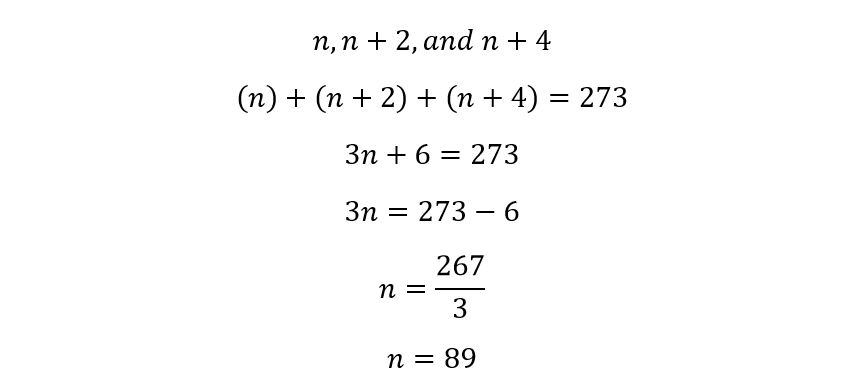
Thus, the three consecutive odd numbers are

(b) Find the missing number in the series:
- 4, 16, 36, 64, ?, 144
- 30, 29, 27, ?, 20, 15
- 1, 7, 15, 25, ?, 51
- 0, 2, 6, 12, 20, 30, ?
- 48, 24, 72, 36, 108, ?
SOLUTION
In such types of questions, one need to find the rule followed in forming the number pattern. To do so, understand the relationship between the consecutive numbers in the series.
(A) 4, 16, 36, 64, ?, 144
In the question, every term of the series is the square of the even numbers in ascending order. Even numbers are 2, 4, 6, 8, …
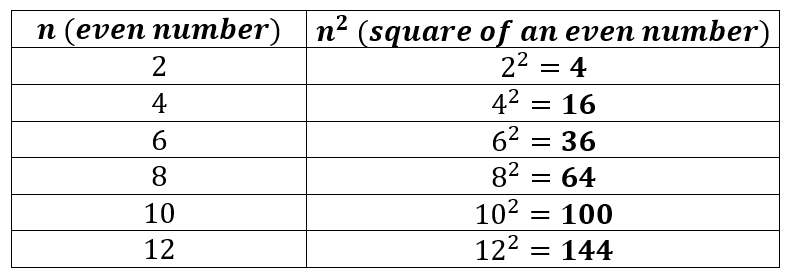
So, the missing number is 100. Hence, the series would be 4, 16, 36, 64, 100, 144.
(B) 30, 29, 27, ?, 20, 15
In the question, the successive terms of the series is reduced by a number, which keeps increasing by 1 from the previous number every time.
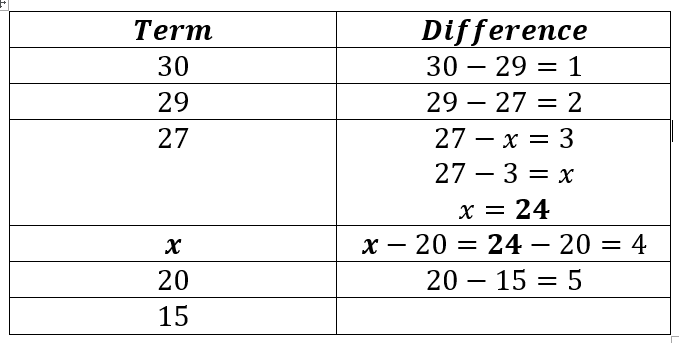
The difference increases by 1, like 1, 2, 3, 4, and 5. Therefore, the difference between 27 and the unknown term must be 3. Kindly, note it’s totally up to the aspirant to find difference between the terms by subtracting the 1st by 2nd or vice versa.
Hence, the series would be 30, 29, 27, 24, 20, 15.
(C) 1, 7, 15, 25, ?, 51
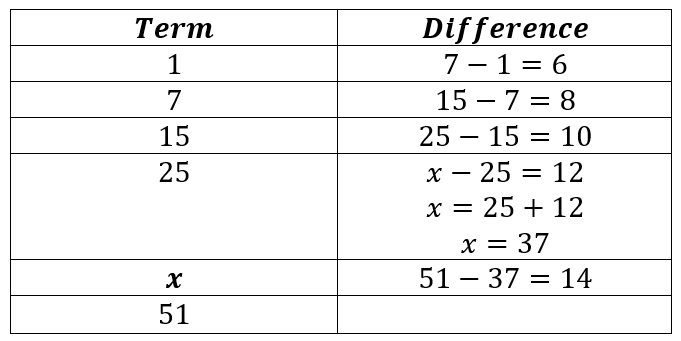
The difference increases by 2, like 6, 8, 10, 12, and 14. Therefore, the difference between the unknown term and 25 must be 12 (10+2).
Kindly, note it’s totally up to the aspirant to find difference between the terms by subtracting the 1st by 2nd or vice versa.
Hence, the series would be 1, 7, 15, 25, 37, 51.
(D) 0, 2, 6, 12, 20, 30, ?
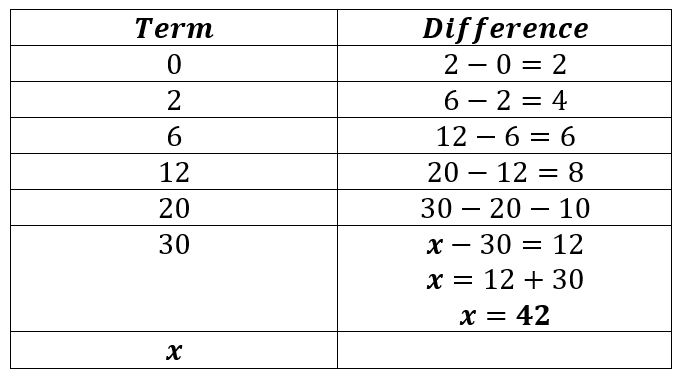
The difference between the terms follows the ascending even order pattern or it increases by 2, like 2, 4, 6, 8, 10, 12, and 14. Therefore, the difference between the unknown term and 30 must be 12 (10+2).
Kindly, note it’s totally up to the aspirant to find difference between the terms by subtracting the 1st term by the 2nd term or vice versa.
Hence, the series would be 0, 2, 6, 12, 20, 30, 42.
(E) 48, 24, 72, 36, 108, ?
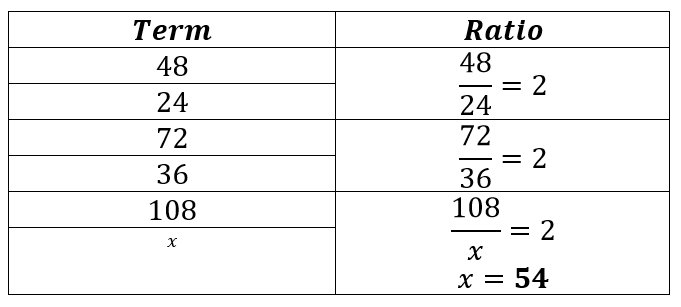
In this question, dividing the first term by second term, and third term by second gives 2. Similarly, the rule is applied for the fifth and sixth term.
Hence, the series would be 48, 24, 72, 36, 108, 54.
(c) Find the correct word from the given jumbled spellings:
- THRSI
- GNDREA
- SCHAMOT
- ONLNDO
- HIODALY
Answer:
| S. No | Jumbled word | Correct word |
| 1 | THRSI | Shirt |
| 2 | GNDREA | Danger/ Garden |
| 3 | SCHAMOT | Stomach |
| 4 | ONLNDO | London |
| 5 | HIODALY | Holiday |
(D) Sara’s mother is 6 times old than Sara, where as her brother Ali is twice as old as Sara. In three years’, time the sum of their ages will be 72. How old are Sara Ali, and their mother now?
SOLUTION
Let the age of Sara be x.
Her mother’s age is 6x.
Ali’s age is 2x.
In three years’, time, their ages would be
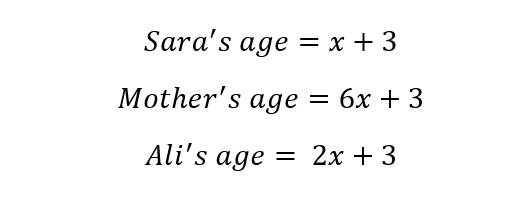
It is given, the sum of their ages will be 72 after 3 years.
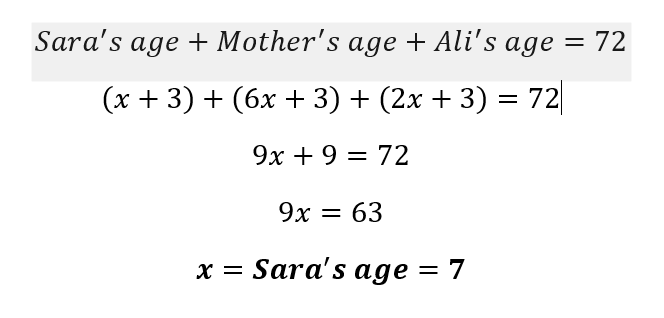
So,

Hence, Sara’s age is 7, her mother’s age is 42, and Ali’s age is 14.
Question-08
(a) What do you understand by Sampling? Discuss non – probability sampling.
Answer:
Sampling:
In statistical analysis, sampling is the act of selecting a predefined number of observations from a larger population. Depending on the sort of study being conducted, the methods utilised to sample from a broader population may include simple random sampling or systematic sampling. There are two types of sampling methods: Probability and Non-Probability Sampling.
Non-Probability Sampling:
In Non – Probability Sampling individuals are chosen based on non-random criteria in a non-probability sample, and not every individual has a chance of being included. The purpose of such type of sampling isn’t to test a hypothesis on a broader scale but to a smaller one.
The Non – Probability Sampling is further categorised into the following:
- Convenience sampling
The population that is easily available or accessible to the researchers is called convenience sampling. For instance, a survey form filled by a specific class in school but not the entire school.
- Voluntary response sampling
In this type, instead researcher approaching to the participants, voluntarily population comes in to the contact of the researcher. For instance, sending a survey form link in the social media groups, only those people would fill form who voluntarily wants to participate; otherwise, other people wouldn’t fill it.
- Purposive sampling
In a part of qualitative sampling, the researcher chooses only those samples that have a significant purpose in the research. For instance, a researcher wants to collect the experiences of the students being handicapped. For this, the researcher has to collect the opinions of inly those students who are handicapped, not who are physically fit.
- Snowball sampling
In this type of sampling, a researcher gets into the contact of the participants with the help of other participants. For instance, a researcher wants to know the number of orphans in the district. For this, he may contact a participant – an orphan – who makes the researcher come into the contact with other orphans he know.
(b) Aslam is willing to use the stylish ceramic tiles in the lounge of his under – construction house. The shape of the tile is right triangle, having the length of the two legs 12 cm and 4cm. Each tile cost Rs. 15. How much will it cost to fill the lounge of 8 meters length and 6 metres width with these tiles.
SOLUTION
First, find the area of one tile.
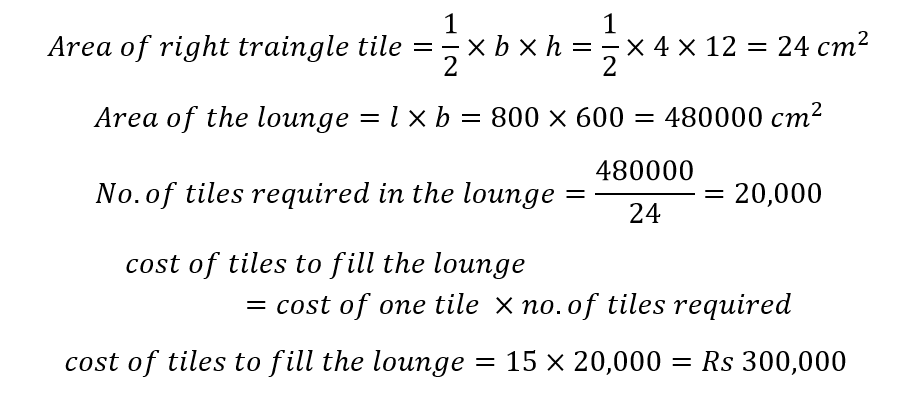
Thus, the cost of tiles to fill the lounge would be Rs. 300,000.
(c) During a sale a clerk was putting new price tags on each item. On one sweater, he accidently raised the price by 20% instead of lowering the price by 20%. As a result, the price on the tag was Rs. 80, too high. What was the original price of the sweater?
SOLUTION
The price on the tag was 80 at the 20% increase in actual price, which means that the price Rs 80 is at the 120% of actual price of sweater.
Let the actual price of sweater be x.
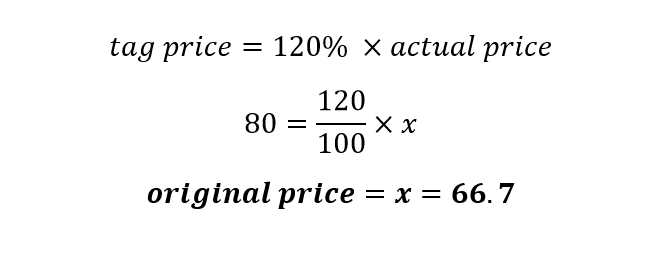
The original price of the sweater is Rs. 67
(d) If in a certain language, BROTHER is written as QDGSNQA, then in the same language SISTER would be written as …..?
Answer:
Solution
In the language, the word BROTHER is equivalent to ODGSNQA. On observing it closely, one may find the following pattern:
In language, a letter that comes first in the word BROTHER has to be compared to the last letter of the word in language QDGNQA. Moreover, the compared letter is always a previous letter of a letter in the word BROTHER.

So, for the word SISTER, the word in the language would be QDSRHR

CSS Solved Past Papers’ Essays
Looking for the last ten years of CSS and PMS Solved Essays and want to know how Sir Kazim’s students write and score the highest marks in the essays’ papers? Then, click on the CSS Solved Essays to start reading them.
CSS Solved Essays

CSS Solved General Science & Ability Past Papers
| 1- | CSS Solved General Science And Ability Past Paper 2023 |
| 2- | CSS Solved General Science And Ability Past Paper 2022 |
| 3- | CSS Solved General Science And Ability Past Paper 2021 |
| 4- | CSS Solved General Science And Ability Past Paper 2020 |
| 5- | CSS Solved General Science And Ability Past Paper 2019 |
| 6- | CSS Solved General Science And Ability Past Paper 2018 |
| 7- | CSS Solved General Science And Ability Past Paper 2017 |
| 8- | CSS Solved General Science And Ability Past Paper 2016 |
| 9- | CSS Solved General Science And Ability Past Paper 2015 |
| 10- | CSS Solved General Science And Ability Past Paper 2014 |
| 11- | CSS Solved General Science And Ability Past Paper 2013 |
| 12- | CSS Solved General Science And Ability Past Paper 2012 |
| 13- | CSS Solved General Science And Ability Past Paper 2011 |
| 14- | CSS Solved General Science And Ability Past Paper 2010 |
| 15- | CSS Solved General Science And Ability Past Paper 2009 |
| 16 | CSS Solved General Science And Ability Past Paper 2008 |
| 17- | CSS Solved General Science And Ability Past Paper 2007 |
| 18- | CSS Solved General Science And Ability Past Paper 2006 |
| 19- | CSS Solved General Science And Ability Past Paper 2005 |
| 20- | CSS Solved General Science And Ability Past Paper 2004 |
| 21- | CSS Solved General Science And Ability Past Paper 2003 |
| 22- | CSS Solved General Science And Ability Past Paper 2002 |
| 23- | CSS Solved General Science And Ability Past Paper 2001 |
| 24- | CSS Solved General Science And Ability Past Paper 2000 |
Articles Might Interest You!
The following are some of the most important articles for CSS and PMS aspirants. Click on any to start reading.












